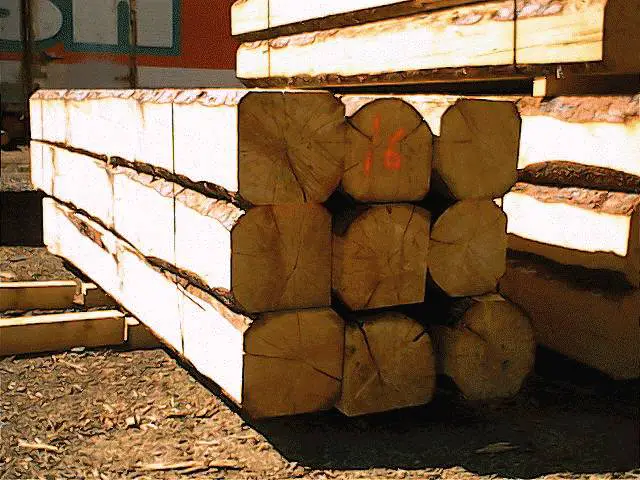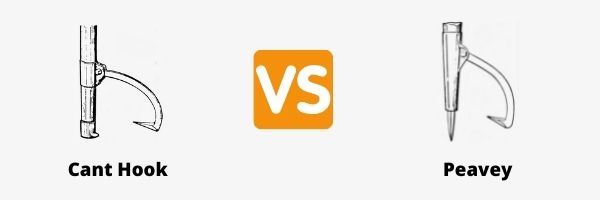A cant hook is a logging tool used to handle and maneuver logs, featuring a long wooden or metal handle with a movable, hooked metal jaw at one end. By engaging the hook into the log and applying leverage, it allows workers to roll, lift, or reposition logs easily and safely during forestry operations.
A cant hook is a tool used by loggers after a tree has been felled and cut into logs. The cant hook has a sharp blade on one end, inserted between the bark and the wood of the tree. The other end has a curved edge, used to cut through the bark and wood when pulled towards oneself.

Table of Contents
What is a Cant Hook?
A cant hook is a tool used by loggers to move logs. It is a sharp, curved blade used for cutting and pulling.
A Cant Hook is named after a ‘Cant,’ a square-edged timber log. A Cant Hook is used to move Cants.
A cant hook moves logs after being cut into manageable lengths, usually about 2-3 feet long. A logger will cut the log into sections and then use a cant hook to pull them out of the forest.
A cant hook is a long-handled tool with a small blade at the end. The blade of the cant hook is on the inside to provide friction. This keeps the log in place without damaging its surface.
The hook is also called a dog and is attached via a pivot point.
Cant hook handles are made from various materials, such as metal, plastic, and wood.

What’s the Difference Between a Cant Hook and a Peavey?
Cant hooks and peaveys both help with moving logs. The main difference between a cant hook and a peavey is that a peavey has a spike rammed into a long while a cant hook has a blunt end.
Joseph Peavey of Maine developed the peavey in 1858 as an upgrade on the cant hook. The spike allows the peavey to move larger logs that the cant hook cannot fully grip.
Many loggers use the terms cant hook and peavey interchangeably as they perform the same function.
One of the drawbacks of a peavey is that the point will damage the log’s surface when applied, so keep this in mind when deciding between the two tools.

| Key Criteria | Cant Hook | Peavey |
| Design Feature | Blunt gripper at the end of the handle. | Spike at the end of the handle. |
| Pros | Has grip on both sides of the hook. | Grips tightly by spiking directly into the wood. |
| Cons | It can slip as it relies on gripping force. | It can damage the surface of the log during use. |
| Suited For | Smalled logs that the hook can fully grip around. | Logs that are larger than the cant hook can get around. |
How Do You Use a Cant Hook?
Cant hooks are used in logging to move logs and other materials. They are a hand tool that loggers use to load logs onto trucks or rail cars. A cant hook is a long pole with a curved metal hook on one end, which is used for picking up logs and “hooking” them onto the truck or rail car. The curved metal hook can be opened and closed using a lever operated by the loggers’ foot. It may be inserted under the log, hooked over its edge, and lifted into position for loading onto the truck or rail car.
A peavey uses a similar technique with some key differences. The main difference is that the spike at the end of the handle is directly penetrated into the log. The dog is then hooked around the log, allowing the log to be rotated or moved. Care should be taken to ensure any damage to the log occurs in a place that doesn’t reduce the value of the wood.
Cant Hook Dimensions
Typical dimensions of a cant hook are as follows:
- Handle Length: 5 feet
- Handle Diameter: 2 inches
- Dog Length: 8 to 14 inches
- Dog Point Length: 3 Inches
Do I Need a Cant Hook at Home?
The primary purpose of a cant hook is to rotate and move large logs. If you have a lot of large logs that you need to move before cutting them into smaller pieces for firewood, then I would strongly recommend adding a cant hook to your tool collection. They make it significantly easier to manage your firewood storage, especially if you are using a hydraulic log splitter.
Conclusion
Cant hooks are handy logging tools used for hundreds of years to help rotate and move heavy logs. If you have been struggling to move your large logs before splitting for firewood, I would suggest picking up a cant hook. They are primarily used in commercial sawmill operations and forestry works.
The main use I have for my cant hook is to position large logs into my log splitter when I have it set up in a vertical position, so I don’t need to lift them up into position.
